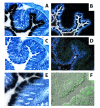Intestinal epithelial serum amyloid A modulates bacterial growth in vitro and pro-inflammatory responses in mouse experimental colitis
- PMID: 21067563
- PMCID: PMC2992040
- DOI: 10.1186/1471-230X-10-133
Intestinal epithelial serum amyloid A modulates bacterial growth in vitro and pro-inflammatory responses in mouse experimental colitis
Abstract
Background: Serum Amyloid A (SAA) is a major acute phase protein of unknown function. SAA is mostly expressed in the liver, but also in other tissues including the intestinal epithelium. SAA reportedly has anti-bacterial effects, and because inflammatory bowel diseases (IBD) result from a breakdown in homeostatic interactions between intestinal epithelia and bacteria, we hypothesized that SAA is protective during experimental colitis.
Methods: Intestinal SAA expression was measured in mouse and human samples. Dextran sodium sulfate (DSS) colitis was induced in SAA 1/2 double knockout (DKO) mice and in wildtype controls. Anti-bacterial effects of SAA1/2 were tested in intestinal epithelial cell lines transduced with adenoviral vectors encoding the CE/J SAA isoform or control vectors prior to exposure to live Escherichia coli.
Results: Significant levels of SAA1/SAA2 RNA and SAA protein were detected by in situ hybridization and immunohistochemistry in mouse colonic epithelium. SAA3 expression was weaker, but similarly distributed. SAA1/2 RNA was present in the ileum and colon of conventional mice and in the colon of germfree mice. Expression of SAA3 was strongly regulated by bacterial lipopolysaccharides in cultured epithelial cell lines, whereas SAA1/2 expression was constitutive and not LPS inducible. Overexpression of SAA1/2 in cultured epithelial cell lines reduced the viability of co-cultured E. coli. This might partially explain the observed increase in susceptibility of DKO mice to DSS colitis. SAA1/2 expression was increased in colon samples obtained from Crohn's Disease patients compared to controls.
Conclusions: Intestinal epithelial SAA displays bactericidal properties in vitro and could play a protective role in experimental mouse colitis. Altered expression of SAA in intestinal biopsies from Crohn's Disease patients suggests that SAA is involved in the disease process..
Figures






References
-
- de Beer MC, Yuan T, Kindy MS, Asztalos BF, Roheim PS, de Beer FC. Characterization of constitutive human serum amyloid A protein (SAA4) as an apolipoprotein. J Lipid Res. 1995;36(3):526–34. - PubMed
-
- Coetzee GA, Strachan AF, van der Westhuyzen DR, Hoppe HC, Jeenah MS, de Beer FC. Serum amyloid A-containing human high density lipoprotein 3. Density, size, and apolipoprotein composition. J Biol Chem. 1986;261(21):9644–51. - PubMed
Publication types
MeSH terms
Substances
Grants and funding
LinkOut - more resources
Full Text Sources
Other Literature Sources
Molecular Biology Databases
Miscellaneous

